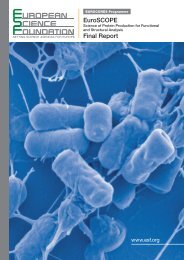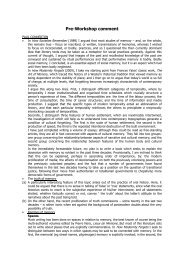Nanomedicine - European Science Foundation
Nanomedicine - European Science Foundation
Nanomedicine - European Science Foundation
You also want an ePaper? Increase the reach of your titles
YUMPU automatically turns print PDFs into web optimized ePapers that Google loves.
12<br />
1. NANOMEDICINE: A NEW OPPORTUNITY FOR IMPROVED DIAGNOSIS, PREVENTION AND TREATMENT FOR DISEASE<br />
World<br />
Africa<br />
very high adult mortality<br />
Americas<br />
low adult mortality<br />
South-East Asia<br />
low adult mortality<br />
Europe<br />
high adult mortality<br />
Europe<br />
very low adult mortality<br />
Western Pacific<br />
low adult mortality<br />
Adult mortality: probabilities of death between 15 and 60 years of age by cause,<br />
selected epidemiological subregions, 2002<br />
HIV / AIDS<br />
Other communicable diseases<br />
Noncommunicable diseases<br />
© WHO world health report 2003<br />
0 100 200 300 400 500 600<br />
Probability of death between 15 and 60 years of age per 1000 population<br />
preparation of carefully tailored synthetic low<br />
molecular weight drugs via traditional medicinal or<br />
combinatorial chemistry;<br />
• nanofluidics for targeted synthesis;<br />
• nanodetection for target identification; and<br />
• discovery of natural macromolecules, including<br />
antibodies, proteins and genes that have inherent<br />
biological activity.<br />
The second, and a complementary approach, is<br />
the creation of drug delivery systems that can act as<br />
a vehicle to carry and guide more precisely the<br />
abovementioned agents to their desired site of<br />
action. In 2002 and 2003, more biotechnology products<br />
(proteins and antibodies) and drug delivery<br />
systems were approved by the US Food and Drug<br />
Administration as marketed products than new low<br />
molecular weight drugs.<br />
Nanosized hybrid therapeutics (e.g. polymerprotein<br />
conjugates) and drug delivery systems (liposomes<br />
and nanoparticles) have already been approved<br />
for routine use as medicines. The drug delivery<br />
systems entering the market have been designed to<br />
achieve disease-specific targeting, to control the<br />
release of the drug so that a therapeutic concentration<br />
is maintained over a prolonged period of time, or to<br />
provide more convenient routes of administration<br />
(e.g. oral, transdermal and pulmonary) and reach<br />
locations in the body that are traditionally difficult to<br />
access, such as the brain. Via the use of coatings,<br />
ever more sophisticated devices are emerging that<br />
allow localised controlled release of biologically<br />
active agents.<br />
Complex supramolecular assemblies, nanoparticles<br />
and polymeric materials in many different<br />
forms are already playing an important role in the<br />
construction of nanopharmaceuticals. It is clear that<br />
the contribution of nanotechnology will continue to<br />
grow in the future, and it is widely believed that<br />
effective delivery gene therapy and other macromolecular<br />
therapeutics will be realised only with the<br />
aid of multicomponent, nanosized delivery vectors.<br />
Non-invasive patient imaging using techniques<br />
such as gamma camera imaging, magnetic resonance<br />
imaging, X rays and ultrasound are important<br />
established tools used to assist diagnosis and monitor<br />
response to treatment. Molecular level imaging<br />
using techniques such as positron emission tomography<br />
(PET) can also provide information on drug<br />
targeting, drug metabolism and disease response to<br />
therapy. Several nanoparticle-based magnetic resonance<br />
imaging (MRI) agents have already been<br />
approved for routine clinical use, and it is recognised<br />
that future application of nanotechnology has<br />
an enormous potential in this field. Complex<br />
supramolecular assemblies are already being<br />
explored in research and development to yield<br />
agents for molecular imaging in the context of MRI,<br />
ultrasound, optical imaging, and X-ray imaging.<br />
Moreover, in the longer term, the combination of<br />
imaging technologies and drug delivery systems has<br />
the potential to yield theranostics devices.<br />
© Schering AG

















